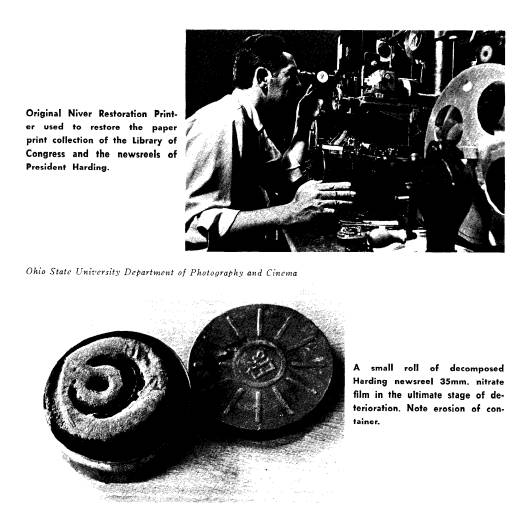Ohio History Journal
ESSAY AND COMMENT
Preservation of the Newsreel Films
of President Harding
by Robert W. Wagner
Efforts of the professional archivist in
his attempt to preserve historical
materials are often complicated by the very nature of
the substance he
is trying to preserve. For example, all
35mm. motion picture film from
1888 to 1951 was made with a cellulose
nitrate base which makes the
reels highly flammable and under some
circumstances highly explosive.
A partially decomposed nitrate film may
ignite spontaneously at 120
degrees F., or even at 105 degrees F.,
if deterioration is far enough advanced.
Another material, triacetate, or so
called "safety" film, was used on 16mm.
and, since 1951, for all 35mm., 70mm.,
and magnetic film and tapes. But
the problem of proper storage of this
film remains. The optimum storage
place for archival films would be in an
airfiltered room at 60-70 degrees F.,
with a relative humidity of 40 to 50
percent. It is now the opinion of the
commerical producers of this film that
black-and-white films should last
as long as high quality paper records,
in proper storage areas.
In 1952 officials of the Library of
Congress, in an effort to find a way
to restore to usefulness its collection
of photographic prints on bromide
paper dating from 1894 that had been
accepted by the United States
Copyright Office as evidence of
ownership of original 35mm. nitrate
motion picture negatives, sought the aid
of the Academy of Motion Picture
Arts and Sciences. Mr. Kemp R. Niver of
the Renovare Film Company in
Hollywood was contacted, and he worked
for more than ten years to develop
a restoration printer. In doing so, he
found it necessary to identify and
solve some twenty-seven separate and
distinctly different technical problems
in the conversion of images from the
opaque bromide paper onto new
16mm. acetate film.
Restoration of archival film in Ohio has
been significantly aided by
the presentation in 1967 of the original
restoration printer made by Niver
to the Ohio State University's
Department of Photography and Cinema.
The first significant task of an
archival nature employing the use of the
new equipment was the project to
preserve the fast-deteriorating 35mm.
newsreel prints of the presidential
years of Warren G. Harding. In 1967,
at the initiative of Daniel R. Porter,
Director of the Ohio Historical
Society and custodian of the film, the
collection of newsreels was removed
from the Ohio State Museum and
transferred to a specially prepared air-
conditioned fireproof room used by the
Department of Photography and
Cinema where cautious handling of the
reels was begun.
|
The identifiable stages in decomposition of nitrate film were all present in the Harding collection, from the discoloration and fading of the image, to the brittleness and flaking of the emulsion, to the sticky or "tacky" condition accompanied by the erosion of the images and a softening and blistering of the base, to a solidification of the layers of film with a frothy exterior appearance, and finally to the appearance of a clinging, brown powder having a very acrid smell, denoting the ultimate stage of decomposi- tion. Some of the material was in good condition while other reels had deteriorated to the stage where it is necessary to destroy the film before it destroys itself. After the retrievable parts of the old film had been transferred onto new 16mm. film, all the old nitrate film was ignited on the university dump, where it burned with a fury which cannot be extinguished by any known means since it produces its own oxygen; it will even continue to burn under water or when sprayed with carbonic acid snow. The newsreel films in the Harding collection were shot by the major motion picture companies of the early twenties, such as International, Pathe, and Fox. Depicted are the highlights of the President's career after |
140 OHIO HISTORY
his election in 1920 until his death in
1923. The film record, however, is
fragmentary and consists of a sequence
of snapshots; it is not a "documen-
tary" presentation as television
viewers of the sixties have come to expect.
It shows the traditional stereotyped
"image" of the American President:
the golfer, the shaker of hands, the
friend of the weak (the American
Indian in Harding's case), the fisherman,
the public ceremonial figure
dedicating monuments and saluting at
parades, and the lover of children
and dogs. But the unrelenting camera eye
reveals Harding to greater
depths than surface gestures, if one is
alert enough to distinguish between
the trivia and the profound.
One may ask whether the restoration of
archival film is worth the cost
and effort. The cost for the Harding
films was from $200 to $300 per 10-
minute 35mm. reel, and the collection
now includes 1600 feet of film
recovered from about 2500 feet of the
original. The time required for
the job included 357 man-hours by highly
trained specialists. Would we
not today treasure a film record of
generations past? Of Alexander the
Great, Julius Caesar, George Washington,
or Napoleon Bonaparte? Do
we of the present generation, therefore,
not bear a responsibility to future
generations to preserve a film record of
our times? With the development
of the Niver Restoration Printer the
immediate technical problems of
preservation have been solved. Now what
is needed is a desire backed
by the necessary funds to support
programs aimed at improving the
technology for restoration work and for
perpetuating our motion picture
heritage--a form of human communication,
creative expression, and
historic documentation so unique to the
United States that cinema has
almost become our second
"language."*
ROBERT W. WAGNER
The Ohio State University
* An expanded version of this article,
entitled "Motion Picture Restora-
tion," appears in The American
Archivist, XXXII (April 1969), 125-132.
